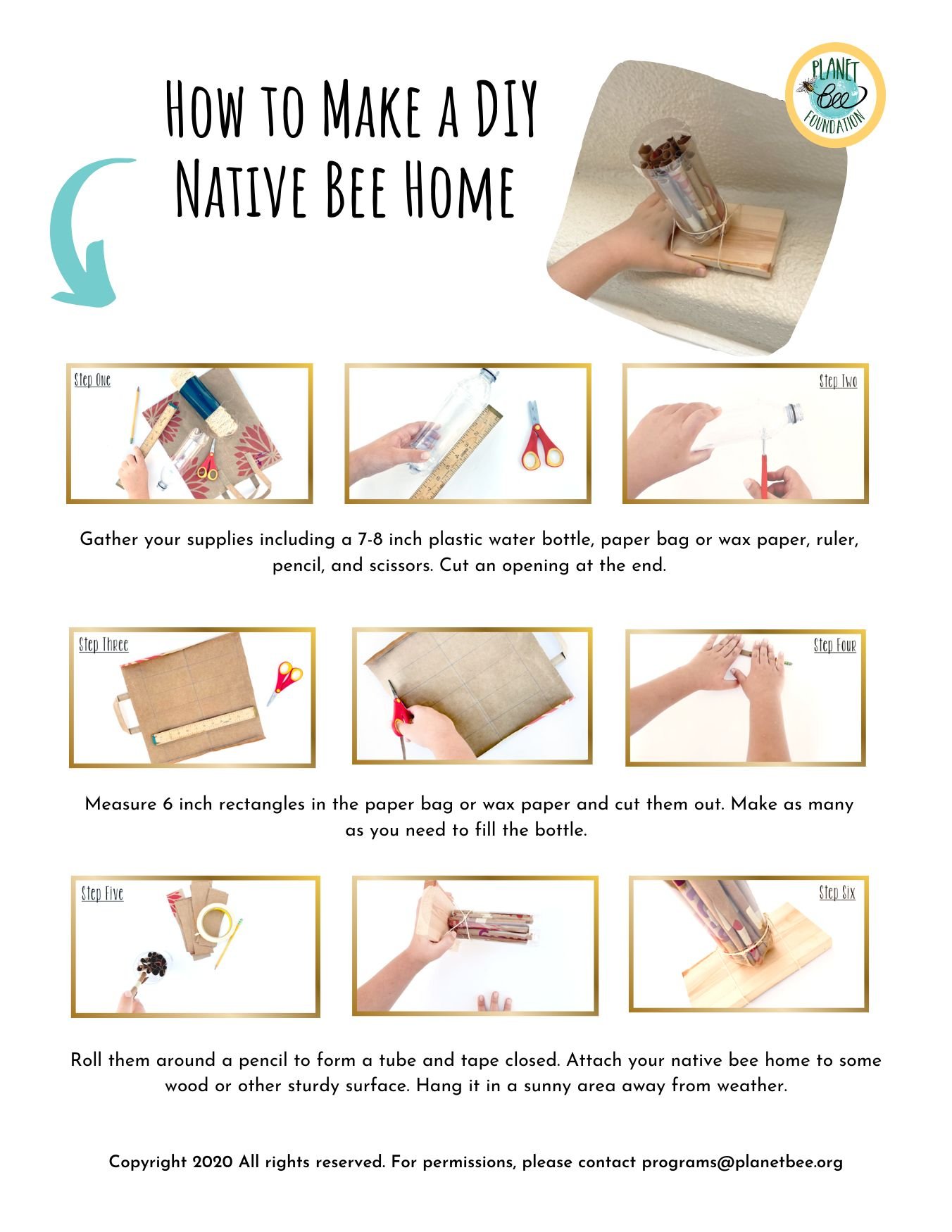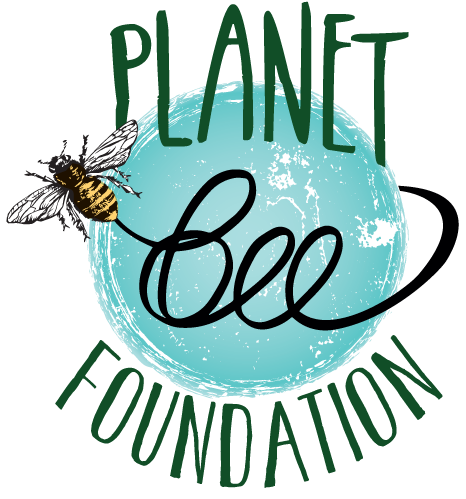MAKE A DIY NATIVE BEE HOME
Help support native bees by building them homes from upcycled materials!
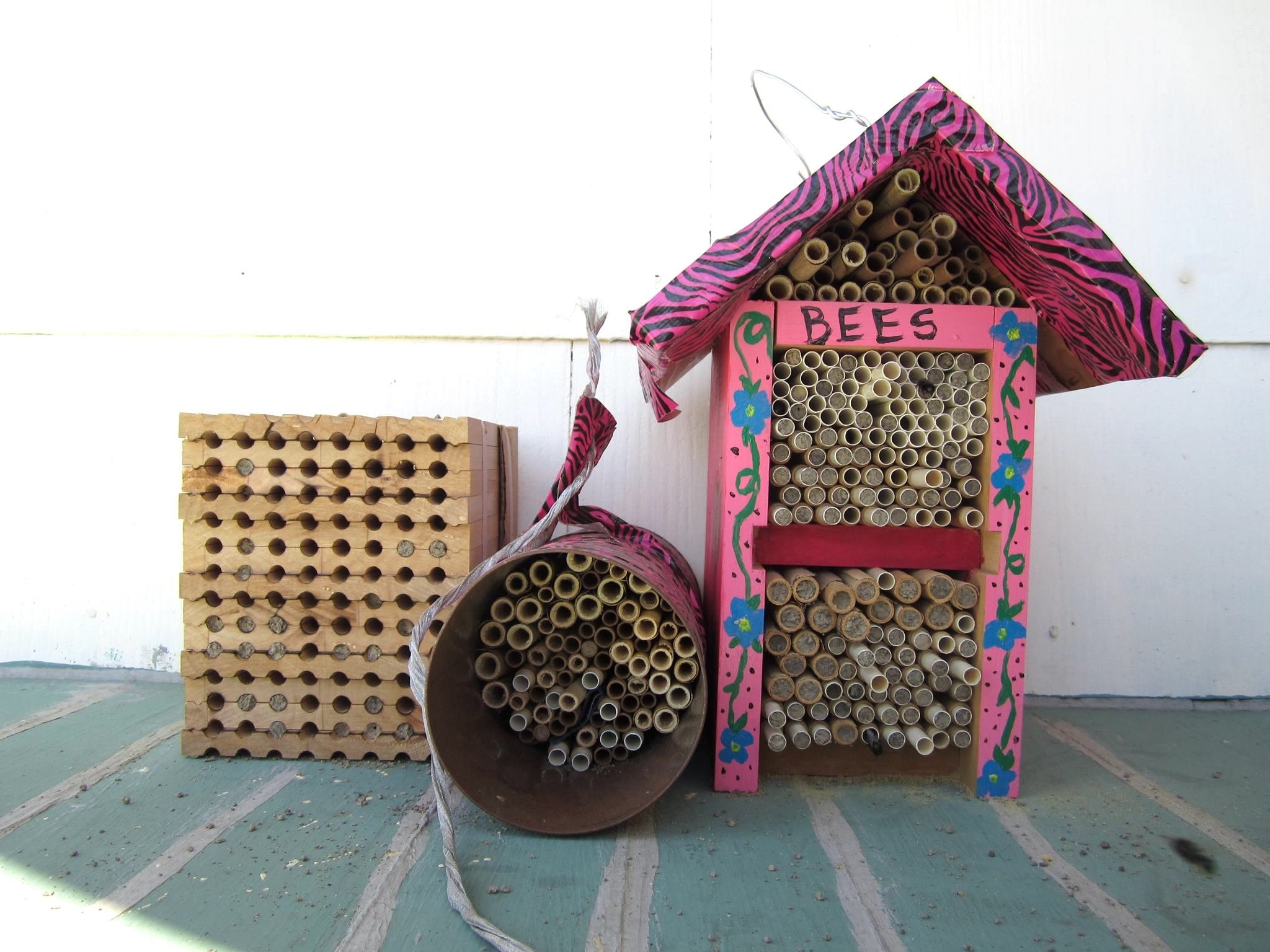
Making a DIY Native Bee Home is a fun project that helps provide habitat for our native pollinators!
Solitary bees often nest in hollow stems or tunnels they find in their habitat. Different bees have different needs and some bees nest best in tunnels that other bees would not find suitable.
Help us understand what works best by joining one or more of our citizen science projects.
First: Decide what type of Native Bee Nest to Create
There are many different types of Native Bee Nests to choose from and lots of variety within types, providing homes for many species of native bees.

Bee Blocks
Use preservative-free lumber: a 4x4 (10 cm x 10 cm) for blocks with shallower depth holes, or a 4x6 (10 cm x15 cm) for blocks with deeper holes. You can use a rough block of wood instead (e.g. a piece of firewood or a fallen log), as long as it has similar dimensions or is larger in cross-section.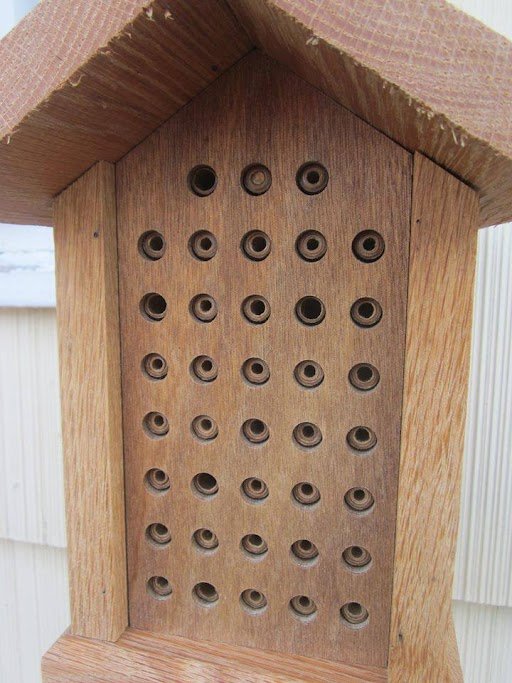
On one side, drill a series of nest holes of appropriate sizes and depths. Holes should be between 3/32 and 3/8 inch (2.5-10 mm) inside diameter. Some studies suggest that the deeper the hole is, the more likely you will be to get female bees or wasps because bees and wasps can control whether they lay a fertilized (female) egg or an unfertilized (male) egg. The mother bee or wasp will often lay female eggs deep inside the hole and male eggs toward the front of the hole. However, some species may prefer small shallow holes- so feel free to experiment!Holes should be separated by at least 3/4 inch (19mm) from center to center and no closer than that to the edges. Attach a backing board if you drill all the way through your block. Bees and wasps might not use a tunnel that is open at both ends. With smaller diameter drill bits, you may not be able to achieve the 3-inch (8cm) minimum recommended depth. If that is the case, simply drill as deeply as you can; bees that use tunnels of smaller diameters often nest successfully in tunnels that are not as deep. Just simply drilling some holes on a wood log also works.The exterior of the block can be rustic or fancy and any color you like. Anecdotal evidence suggests that bees are most attracted to dark nest blocks. As a final step, you can attach an overhanging roof to provide additional shelter from the rain.It may be important to mount the block so that it does not move or shake in the wind as movement might disrupt the nesting and larval development. The actual height from the ground may play an important role in the species you find nesting. You can try a series of heights to see what works best in your area. If the nest is too low you may get flooding from rain and vegetation may cover the holes. Our nests are between 1' and 6' (0.3 m and 1.8 m) above the ground, although there may be species that prefer higher or lower.
Stem Bundles
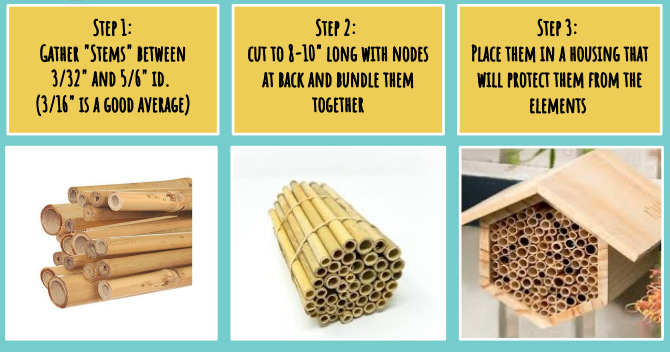
Artificial nests can be constructed with bundles of reed, bamboo or other hollow-stem plants. You can also try using plants with pithy stems that can easily be excavated by bees and wasps. Another option is to drill holes into branches to imitate a hollow stem.Non-native bamboo can be quite invasive and a quick search online might lead you to a homeowner that would happily have you clear some of the bamboos from their yards. It may be best to cut bamboo below a node (usually indicated by a ridge) to create a handful of tubes each with one open end and one closed end. Strap the tubes together into a tight bundle with wire, string, or tape.You can also try paper or cardboard tubes, plastic drinking straws (stirrers to boba size), aquarium tubing, or other materials.Tightly pack the stems into a can, bucket, pitcher, or short section of PVC pipe, a wooden frame or an open-faced birdhouse.
Mud Mansions

Some solitary bees and wasps will nest in cracks or cavities in soft clay or in dry, exposed soil embankments. Some species, such as Anthophora abrupta and A. urbana will wet the hard soil surface with water or nectar to soften it enough to excavate tunnels. These species are quite common in the southern United States and are both important visitors of some fruit and vegetable crops. To attract these species, dried mud bricks can serve as the equivalent of a wooden nest block. Such adobe bricks can sometimes be purchased, in which case you can increase their attractiveness to bees by drilling nesting holes following the size recommended.Mud Mansions are easy to make where clay soils are common. To create one, half-fill a large plastic bucket with clean clay soil, and then fill the bucket with water. Stir the mixture into a slurry, and then allow it to settle. Remove sticks or debris that float to the surface, and slowly pour off most of the water. Finally, pour the remaining sediment into a mold (such as a shoe box-sized wooden box). Allow the block to dry for several days or weeks. Before it dries completely, make several indentations. Mount the brick, or stack of bricks, facing east or southeast to catch the morning sun. Adobe will not hold up well in wet climates, so the block may need sheltering from the rain.
Next: Pick your Size Hole
- The best inside diameter for the tunnel depends on the size of the bee
- A diversity of sizes will often result in a diversity of bees (a good thing)!
- (see our bee size chart for more details) a range between 3/32”- ⅚”

Then: Maintain Your Native Bee Nest
Whether your nests are wooden blocks, stem bundles, or other materials, in order to be sustainable, they will need routine management and regular replacement. This is important to prevent the buildup of bee parasites and diseases that affect the developing brood. Each year, inspect your nest from the previous year. If the material was directly nested in, you may want to either clean it or replace it. Every two years, phase out wooden and adobe nest blocks and stem bundles by placing them inside an emergence chamber at the beginning of the season when the adults are active. This is a dark container such as a lightproof wooden box, a dark-colored plastic bucket with a tight-fitting lid, or even a sealed milk carton that has been spray-painted black to reduce light infiltration. Drill a single 3/8-inch (10mm) exit hole in the bottom of the light-proof container and set the entire contraption outside, adjacent to a new nest block or stem bundle. As bees emerge from the old nest, they are attached to the light of the exit hole and emerge to find the new nest hanging nearby. Locating the escape hole on the bottom of the dark container means the bees can crawl out rather than attempt to fly out. At the end of the season, remove the old nest block or stem bundle from the emergence box and dispose of it.Disinfect Nest Blocks
Line the tunnels of wooden nest blocks with tight-fitting removable paper straws. At the end of the nesting season (autumn), gently remove the straws (with bees in them) and place them in a ventilated container stored either in a refrigerator or in an unheated barn or garage. Disinfect nest blocks after the straws have been removed by submerging them in a 1:3 bleach-water solution for a few minutes, ensuring that no air bubbles remain in the holes. In the spring, place the old straws inside an emergence chamber and place new straws inside the disinfected block.Dealing With Ants
Ants can be a problem as they forage in your nest for pollen, prey, immature bees, and wasps. We use tanglefoot, a non-toxic mechanical control that prevents the ants from climbing up a post or down a wire. You can also try oil-based jellies or other products but avoid anything toxic and avoid chemicals that would kill the ants as these same chemicals may kill the bees or wasps.Dealing With Woodpeckers
To protect against woodpecker damage, you might want to store your nests in an unheated building at the end of the season. Alternatively, you can protect nests over the winter by surrounding them with hardware cloth or chicken wire. Be sure to remove it before nesting resumes, as it can disorient nesting bees and damage their wings.Offer Smaller Blocks & Bundles Around the Property
Create multiple small nest blocks or stem bundles with only a few nest tunnels (4 or 6), and scatter them across your property, at least 25 feet (8.0 m) or more apart. This prevents the unnaturally high populations of bees found at nest blocks with many holes, and it mimics natural conditions of limited, spatially separated nest sites. These smaller nests also decompose more rapidly. They can simply deteriorate naturally as you add new small nests to the landscape periodically.Native Bee Basics

There are an estimated 20,000 species of bees worldwide and the majority are solitary bees. Because of their solitary lifestyle these bees do not defend their nests, and although some are physically capable of stinging they will generally not do so unless roughly handled. This makes solitary bees a relatively safe model organism to facilitate lessons on biology, plant/insect interactions, ecology, and more. The solitary bee female mates with a male and then begins her nest. In natural settings solitary bees burrow in the ground or nest in preexisting cavities such as beetle burrows, holes made by woodpeckers, hollow stems and reeds, and even empty snail shells! The size of the cavity, material, orientation, and other factors dictate the suitability of the cavity for different species of solitary bees. When a suitable nest location is decided on, the female bee collects pollen and nectar and provisions the nest. She lays an egg on the provisioned food and then seals off each cell. The larvae will hatch from or absorb the egg and then feed on the food provision in the cell. After this eating and growing stage, the larvae become a pre-pupae. The pre-pupae spin webbing is similar to a cocoon and then goes into the pupa stage. The adult bees will then emerge, chew through the sealing materials and repeat the lifecycle. The time it takes to go through each of these stages may be dependent on the species of bee, the time of year, temperature, or other environmental factors. Different bees also use different sealing materials. For instance, as their name suggests, the leaf cutter bee cuts semi-circle pieces from leaves to line the inner cavity of the nest, create individual cells, and cap off the nest. The mason bee uses mud to create a cement-like seal between the cells. Some solitary bees use flower petals, others use plant resins or fibers and others secrete a waterproof wax-like material to line their cavities and/or seal their cells.
The Importance of Solitary Bees
Fruit, vegetable, and seed crops are directly dependent on animal-mediated pollination as are many crops providing human medicines, fibers, fuels, and livestock forage crops. Bees are specialized pollinators covered with branched hairs that facilitate the transfer of pollen. Bees require pollen as a source of food particularly during the larval growth phase. Bees are attracted to flowers for nectar, pollen, and essential oils. As they forage for these necessities they inadvertently transfer pollen from plant to plant increasing the fruit and seed set as well as the genetic diversity of the plants they visit. Parallel declines between pollinators and the plants that depend on their pollination services have been identified. The fates of agricultural and natural plant communities are therefore closely linked to the fate of pollinators.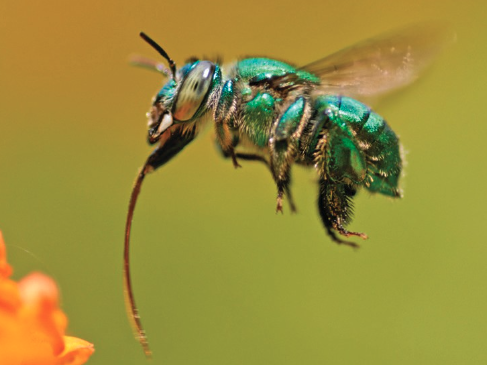
The European honey bee, Apis mellifera, is the most commonly managed pollinator and is in decline due to pests, pathogens, pesticides, and the recent phenomena termed colony collapse disorder. Managed honey bee colonies in North America have declined to 2.3 million as of 2008, down from nearly 6 million hives in the 1940s. The plethora of problems facing the European honey bee emphasizes the importance of our native bee communities. The European honey bee is, after all, only 1 of an estimated 20,000 species of bee worldwide. In North America, there are approximately 4,000 species and 300+ species have been identified in Florida alone. Research has shown that some bees may be better at pollinating certain crops than the European honey bee. Many of these bees fly in conditions that honey bees would not. Bumble bees for instance have been known to fly in rainy weather and on days when there is snow on the ground. Bumble bees also use "buzz pollination" or "sonication" to vibrate the pollen from the anthers of some flowers which do not readily release their pollen. Some bees fly earlier and later than honey bees. Some bees have shorter or longer tongues than the honey bee allowing them to gain access to flowers unavailable to the honey bee. Unfortunately, only a few alternative bees have been successfully managed as pollinators to date. In the 1880s four bumble bee species were introduced into New Zealand from England, increasing the production of red clover seed as intended. Bumble bees (Bombus terrestris, B. lucorum, B. occidentalis, B. ignitus, and B. impatiens) have since become available commercially through intensive laboratory rearing creating a multi-million dollar industry. There are concerns over transporting them to non-native areas as they can carry and transmit pests and pathogens to local bees. The hornfaced bee, Osmia cornifrons has been studied for over 60 years and is now being used to pollinate ~80% of orchards in Japan. Millions of leafcutter bees, Megachile rotunda, are raised annually to pollinate alfalfa in North America. The alkali bee, Nomia melanderi, is another bee that supports pollination in the Midwest. An estimated 80% of native pollen bees nest in the ground. The only ground-nesting bee currently being managed (albeit at low levels) is the alkali bee (Nomia melanderi). The alkali bee is generally found in soils with a thin layer of salt at the surface level that regulates the moisture of the soil- a very specific habitat. The alkali bee looks like a small honey bee but has iridescent yellow or green bands on its abdomen. The alkali bee is an excellent pollinator of alfalfa and onion seed. The female collects pollen and nectar and then digs a hole in the soil about 10-20 cm deep. She then constructs a small cell and provisions it with a pollen-mass, lays an egg on the pollen-mass, and then seals the hole. The alkali bee needs a very specific soil with high salinity on the surface to trap the moisture content. The chimney bee (Anthophora abrupta) is a gregarious, yet solitary, ground-nesting bee. These bees nest in burrows conspicuously adorned with chimney-like turrets. The neighboring nests are clustered like a small village, but the bees are solitary because there is no overlap of generations and each female cares only for her own nest and future offspring. They are not aggressive or even defensive of their nests and do not sting. When roughly handled, they can defend themselves by biting but are otherwise docile and should not be considered a threat. While still unmanaged, they are in fact beneficial pollinators and have been recorded on a variety of flowers. Many solitary bees and wasps nest in pre-existing cavities in plant material such as hollow reeds, stems, branches, and in holes created by wood-boring insects. Wood-nesting, solitary bees locate an appropriate hole, collect pollen and nectar, provision the hole, lay an egg on the pollen/nectar ball, and then create a cell by sealing off the egg with its provision. They continue this process until the hole is filled with cells, at which point they search for another hole. Wood-nesting, solitary wasps do not provision pollen and nectar for their progeny; instead, they collect small arthropods such as caterpillars, crickets, and spiders. The wasp paralyzes the prey by sting and carries it to a preexisting hole or straw that it has selected for a nest. The wasp then lays an egg on the provision, seals the chamber, and continues the process much the same as the bee. This behavior is beneficial in that the wasp may help control herbivorous insect pests such as the armyworm or the grasshopper. Many other solitary wasps also visit flowers for nectar and to hunt prey and therefore may also contribute to pollination.Dr. Krombein investigated the potential of artificial cavities as trap-nests to study the natural history and biodiversity of wood-nesting bees and wasps. In doing so, he added a wealth of knowledge to the scientific community including largely unknown data on 43 bees, 75 wasps, and 83 parasites or predators associated with wood-nesting bees and wasps. Since this seminal work, several investigators have used trap nests to evaluate population dynamics, biodiversity, and habitat use by wood-nesting bees and wasps. These studies show that the diversity and habitat use of wood-nesting bees and wasps differ by location, habitat, and landscape context. Managing alternative bees for pollination adds value to agricultural production and helps to insure our food sources. Large agricultural operations need a higher level of pollination than is available from the local population of native bees. A “pollination industry” has arisen to supplement this service as beekeepers and commercial bee suppliers sell or lease bees to growers. The European honey bee, our most commonly managed pollinator, is in decline due to pests, pathogens, pesticides, and the recent phenomenon termed colony collapse disorder. The plethora of problems facing the European honey bee may also be affecting these lesser-known native bee species. Monitoring these native bees in backyard habitats will hopefully provide a deeper understanding of these unsung heroes.
Make a Native Bee Nest from Found Objects!
